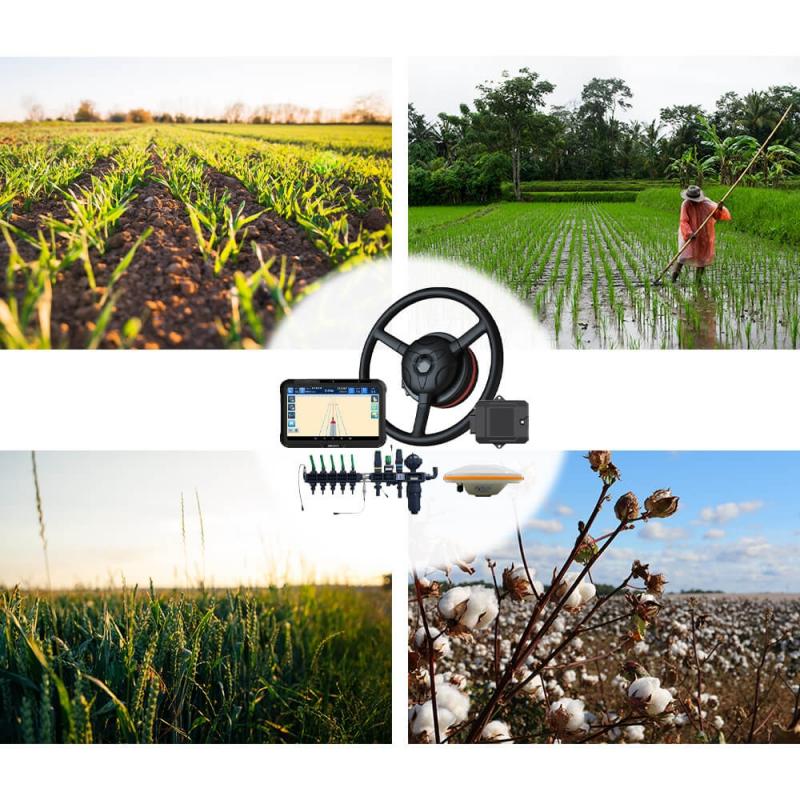What is smart agriculture spraying system?
An intelligent spray control system uses satellite navigation system positioning, speed, and other data, combined with pressure sensors, flow meters, and other sensor information. Through controller automation, these systems intelligently control the on-off valve opening size and ratio to achieve different operating speeds, enabling the realization of liquid-state fertilizer and medicine for uniform spraying. It is possible to prevent human error and other circumstances from causing various operating speeds to result in the spraying of excessive or insignificant amounts of drugs or fertilizers, damage to the drugs or the fertilizer, or inability to have the intended effect. Utilizing the system will help to further realize the precise and accurate spraying control of the dosing machine by preventing or reducing the occurrence of such phenomena.
The features of smart agriculture spraying system:
The system is primarily utilized in conjunction with the spray rod sprayer for precise and quantitative spraying of chemical herbicides, insecticides, or micro-fertilizers, which are widely utilized in cotton, corn, soybeans, wheat, rice, and other crops, plant protection operations using Chinese herbal herbage, and other agricultural spraying operations.
- The terminal shows the amount of medicine still in the cabinet in real time;
- The Real-time return operating area at the terminal.
- It may be applied to both intelligent spraying and autonomous driving.
- It is greater control precision based on flow control.
- It may directly control a valve in the 1-20 section.
- Real-time operation track display makes it simple to locate an unsprayed spot midway through adding the medicine.
The product's fundamental principle:
In the display control terminal, the user may adjust parameters such as the spray amplitude, the number of nozzles, and the intended spray volume. Using a GNSS receiver transfers the received satellite signals to the display for the system's speed and location information and the gathered parameters. The sensor also transmits information to the display panel. Following the commencement of the spraying operation, the system determines the desired spraying rate using the parameters established by the vehicle speed. It contrasts it with the flow meter’s current measurement of the spraying rate. Controlling the opening alters the spraying amount. Adjust the flow valve's angle by maintaining the present spraying rate within the desired range.
What is the advantage of smart agriculture spraying system?
The exact automated management of spray at various speeds is made possible by the coordinate and speed data provided by the satellite positioning system.
- The system will be exact and automated, and the dose per mu (per hectare) may be adjusted following the situation.
- Reduce leakage or repetitive spraying using an auxiliary navigation device that displays departure from the navigational line.
- The drawing operation track, in real time, shows operation area, repetition, and leakage.
- It is several terminal alternatives, including those that support 7", 10, and other color terminal displays.
- The Return of operation data, cloud-based real-time monitoring of the dose, position, and other aspects of operations, etc.
- Assessment of operation quality (area, dose, control precision, different early warning tips, etc.), improvement of operation quality, and reduction of labor effort.

Using Smart Agriculture Spraying Systems to Increase Crop Yields:
Innovative technical solutions like smart agriculture spraying systems can increase crop yields by strategically applying agricultural inputs like pesticides, fertilizers, and herbicides. These systems target and deliver inputs with better accuracy and efficiency, minimizing waste and maximizing efficacy. They utilize cutting-edge sensors, data analytics, and precise equipment. The following are some significant ways that spraying systems for smart agriculture might increase crop yields:
- Precision Application:
Smart spraying systems use sensors and mapping technology to precisely identify and target the fields that need to be treated. The systems can provide the essential inputs just where they are required by mapping the crop health and locating regions with particular insect or weed pressures. With this focused strategy, less spraying is required, input costs are minimal, and potential environmental effects are avoided.
- Variable pace Application:
Smart spraying systems can change the pace at which inputs are applied in response to the particular requirements of various fields. The systems may administer inputs at different rates across the field by considering elements, including soil fertility, moisture content, crop density, and insect pressure.
- Real-time Monitoring:
Smart spraying systems continually monitor numerous environmental and crop health indicators throughout spraying operations. As conditions change, this real-time monitoring enables quick modifications to application parameters. For instance, the system can immediately stop spraying if wind speed exceeds the ideal range. This will happen until the situation becomes better. This guarantees that inputs are administered in the best possible way, minimizing drift and increasing their efficacy.
- Efficiency and automation:
Smart spraying systems are frequently automated, which lowers the amount of physical labor necessary for spraying activities. Automated systems enable prompt input applications since they can run constantly, even at night or inclement weather. Farmers can now cover more areas in less time because of their improved operational efficiency, which helps raise agricultural production potential by ensuring that crops receive timely treatments when necessary.
- Environmental Sustainability:
Smart spraying systems help to maintain the environment's sustainability by reducing input waste. They restrict possible pollution and ecological impact by reducing the chemicals discharged into the environment. Additionally, focused application minimizes negative effects on beneficial species and lowers the chance of pesticide resistance, maintaining ecological harmony within agricultural environments.
Conclusion:
The way farmers manage their crops is revolutionized by smart agricultural spraying system. These systems can detect and treat just the crop parts that require treatment by utilizing cutting-edge technology, which minimizes waste and boosts yields. Additionally, smart agriculture spraying systems' data collection and analysis capabilities may assist farmers in making educated decisions regarding their crops and best practices. The technical staff of SMAJAYU has more than ten years of experience and knowledge. You will have a better experience because of our team's advanced technological skills, creativity, and dependability.


